Anatomy of pH Electrodes
Methods of pH Measurement
What are pH electrodes and how do they work?
The hydrogen ion activity of a solution may be measured using visual, photometric, and potentiometric techniques. To estimate pH, visual and photometric methods rely on colour changes in particular organic pigments. Visual techniques use visual indications such as pH test strips, whereas photometric methods use a light to shine through the sample and measure the absorbance.
The use of visual or photometric pH determination is restricted. If the solution to be measured is cloudy or has an inherent colour, measurements will be unreliable. Some measuring solutions can contain chemical linkages that oxidize or reduce the colour indicators, resulting in erroneous findings.
The electrical potential of pH-sensitive electrodes is used as a measuring signal in potentiometric techniques to detect pH. The drawbacks of visual and photometric techniques are not present when using a pH probe with potentiometric methods. Potentiometric pH measurement may be utilized in nearly any application due to the high sensitivity and selectivity of potentiometric sensors.
A distinction is made between hydrogen, metal (e.g. antimony), and glass electrodes, with the glass electrode being the most commonly used pH sensor.
How do pH probes work? The glass pH probe is an example of an ion selective electrode (ISE). This measuring system basically consists of the ISE reacting on a special ion type, in this case the hydrogen ion, and a reference electrode that are jointly immersed in the sample to be measured.
The hydrogen ISE generates an electrochemical potential that is affected by the solution's hydrogen ion activity. The reference electrode, on the other hand, is designed to generate an electrochemical potential independent of the sample's composition. Based on the Nernst equation, the difference between these potentials, the voltage (mV) shown on a pH meter, defines the pH value.
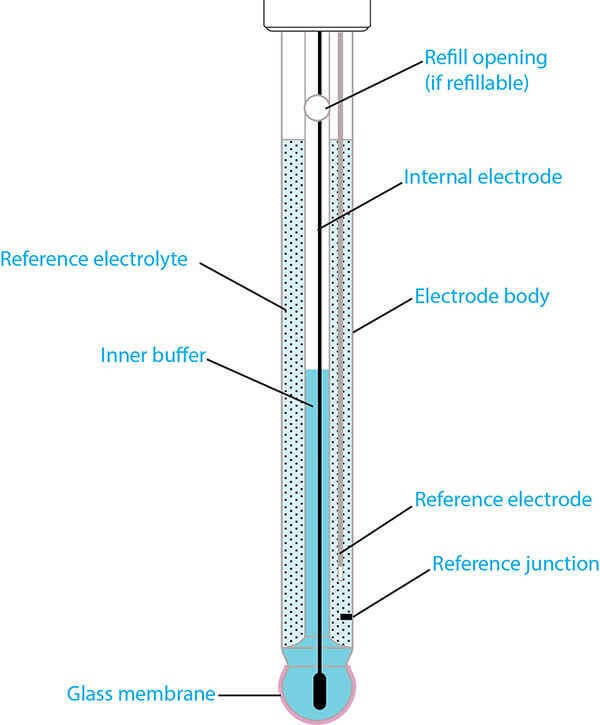
Glass pH Electrode Structure and Design
A typical pH electrode consists of several unique structures, each of which can be seen in the image. The principle components are the electrode body, pH-sensitive glass membrane, reference electrode (i.e. reference system), reference electrolyte, and the reference junction.
Electrode Body
The term ‘glass electrode’ is not indicative of the material used to construct the electrode body, as electrodes can have either a plastic or glass electrode body. Rather, ‘glass electrode’ is used to describe the membrane material (i.e. glass membrane).
Plastic body electrodes are more robust and less prone to fracture than glass, thus all YSI field electrodes are made of plastic. For the lab, YSI supplies both glass and plastic body electrodes, with glass electrodes usually having a wider operating temperature range.
Field pH probes from YSI aren't always made completely of plastic. The pH detecting module of ProDSS and EXO pH sensors is made of plastic, however the remainder of the electrode body is made of titanium for field endurance. In this image below, a ProDSS pH/ORP sensor can be observed.

Image: YSI ProDSS pH/ORP sensor
Glass Membrane
A glass membrane is fused on to the glass electrode as a pH sensor. A buffer solution with a specified pH (usually pH = 7) is poured into this membrane. This electrode design produces an environment on the inside of the glass membrane with constant H+ ion binding, while the outside of the glass membrane is exposed to the sample, which contains a variable number of H+ ions. The difference in H+ ions generates a potential that is read in comparison to the reference electrode's steady potential. The membrane form can change to ensure appropriate moistening of the glass membrane. For most applications, sphere and cone membrane forms can be utilized, although specialized membranes, such as the spear tipped TruLine 21 for penetrating semi-solid media and the TruLine 27 with a flat membrane for surface measurements, may be required (Image below). The numerous types of pH membranes are listed in Table 1.
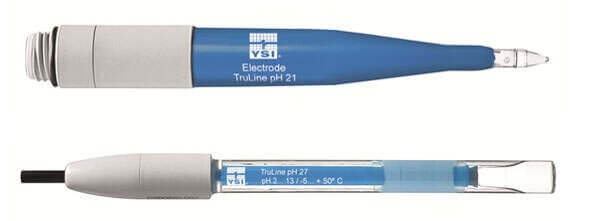
Image: YSI TruLine 21 (spear tip membrane) and YSI TruLine 27 (flat membrane)
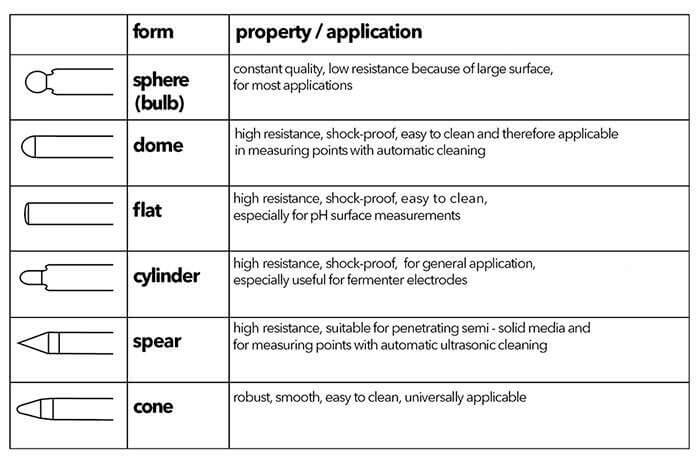
Table 1: Glass Membrane Shapes
Why Is a Reference Needed?
The measurement of a voltage is required for pH measurement with a glass pH electrode. Two locations with distinct electrical potential values are required to measure the voltage. The reference electrode is designed to keep a consistent electrical potential regardless of sample composition or temperature. The electrical potential of the hydrogen ion selective electrode (ISE) with glass membrane, on the other hand, is determined by the activity of hydrogen (H+) ions in the sample solution. When calculating pH, both the reference electrode and the hydrogen ISE are required.
Types of Reference Systems
The hydrogen ISE (i.e. the electrode with the glass membrane) and the reference electrode/system can be distinct electrodes (Image 4) or they can be integrated into a single electrode for convenience (Image 1 and Image 5).Combination electrodes are quite frequent, and all YSI electrodes are combination electrodes. Regardless of the electrode design or the type of reference system used, the reference electrode is immersed in reference electrolyte (typically KCl). The reference electrolyte will be discussed in more detail.
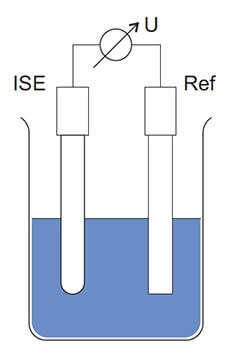
Image: Schematic structure of a hydrogen ISE, reference, and voltmeter
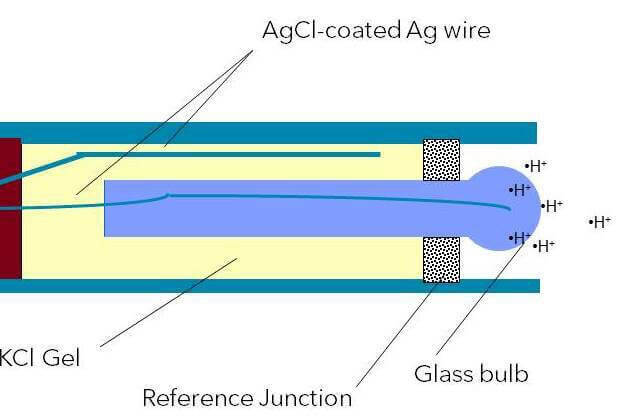
Image: Combination pH electrode with KCl gel reference electrolyte
The silver/silver chloride (Ag/AgCl) system is the most common type of reference electrode used today. Because silver is non-toxic to people, Ag/AgCl electrodes can be utilized in places where hazardous mercury and thallium systems are forbidden, such as medicine and food technology. Ag/AgCl disposal is also less essential than thallium and mercury disposal. Because Ag/AgCl has a wide range of temperature applications (up to 140°C), it is also ideal for sterilizable electrodes.
The Ag/AgCl reference system is found on the majority of YSI electrodes. For the longest period, the mercury chloride (Hg/Hg2Cl2) system has been in use. In the presence of KCl, this reference system has the highest stable potential. Due to the toxicity of mercury, it is now only utilized in extreme circumstances. Furthermore, when using mercury chloride, the temperature range that is dependable is rather limited. Hg2Cl2 begins to deteriorate at temperatures over 60°C. The iodine/iodide system is a relatively new reference system with a quick response time that was created lately. Electrodes with iodine/iodide reference systems have a significantly lower temperature sensitivity than electrodes with Ag/AgCl reference systems, since the temperature coefficient of this reference system is virtually zero.
Metal ions are not present in the iodine/iodide method, which is particularly advantageous when measuring in Tris buffer and protein solutions. Metal-ion-based reference systems (e.g. Ag/AgCl) will react with these solutions, clogging the reference junction. The advanced YSI IoLine series of pH electrodes feature an iodine/iodide reference system. The unique colour of the IoLine reference can be seen below.

Image: YSI IoLine pH electrode
Properties of a Good Reference Electrolyte
The junction, which serves to close the electrical circuit in the electrode, connects the reference electrolyte to the sample. Certain characteristics must be present in a suitable reference electrolyte. The reference electrolyte must be chemically neutral and have high electrical conductivity. Because certain electrolyte leaks into the sample during measurement, it's critical that the electrolyte doesn't react with the measurement solution. The ions of an electrolyte solution must also be equally mobile. If ions in the electrolyte solution diffuse at different rates, an electrical potential (i.e., diffusion potential) can form due to the division between the positive and negative charge. This unwanted potential can be quite troublesome when measuring pH. With some ions (e.g. K+ and Cl-), the differences in diffusion speed are small, resulting in a much smaller diffusion potential.
Potassium chloride (KCl) possesses all of these qualities. As a result, KCl is the most commonly used electrolyte solution.
Form of Liquid Electrolyte
Electrodes can have a gel, polymer, or liquid electrolyte. All YSI field electrodes and some YSI lab electrodes (e.g. TruLine 25 and TruLine 26) feature a gel electrolyte, while most YSI lab electrodes feature a liquid electrolyte reference that can be refilled. Polymer electrolyte is used in specialized YSI electrodes with a flat tip (TruLine 27) and spear tip (TruLine 21).
Liquid Electrolyte
Liquid electrolyte electrodes may usually be replenished, resulting in a longer electrode life.As a result, unlike a gel electrolyte electrode, the electrolyte may be readily drained and changed if it becomes contaminated.
It's crucial to note that while using a YSI lab electrode with refillable reference, the refilling aperture must always be open throughout calibration and measurement! Also, make sure the electrolyte fill level is at least 2 cm higher than the calibration and/or measurement solution level.
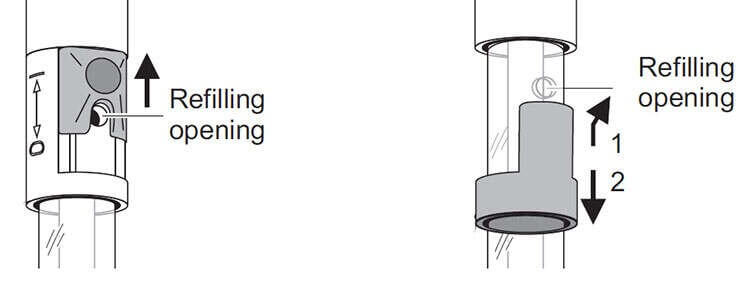
Image: Slider (left) and stopper (right) refill openings for YSI lab electrodes
Liquid electrolyte electrodes generally have a faster response time. Also, because gel and polymer electrolytes are less resistant to temperature and temperature fluctuations, electrodes with liquid electrolytes offer a wider variety of applications. The extremely low outflow rate of gel and polymer electrolyte in strongly acidic, basic, and low-ionic strength solutions can cause measurement errors owing to the development of diffusion potentials, unlike electrodes with liquid electrolyte. All YSI refillable lab electrodes utilize 3 M KCl for the reference electrolyte. However, since the electrolyte is connected to the sample via the junction, some applications require specialized electrolyte solutions.
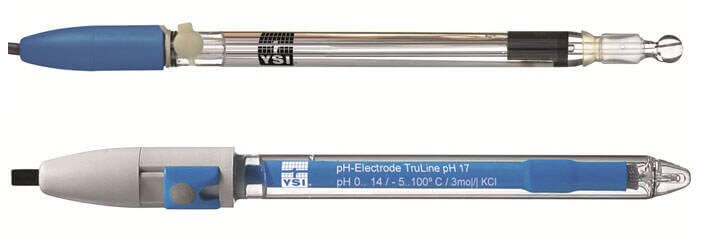
Image: YSI refillable lab electrodes (Science pHT-G and TruLine 17)
Other electrolytes that fulfil the needs of the sample application can be used with the YSI IoLine electrode design. If a totally chloride-free electrolyte (i.e. not KCl) is required, another bridge electrolyte, such as 0.6 M potassium sulfate (K2SO4), can be utilized with the IoLine.
Gel and Polymer Electrolyte
Although the electrolyte in the gel is still KCl, a gelling agent is added to prevent the electrolyte from easily seeping into the sample through the reference connection during measurement. These electrodes are easy to maintain since there is no need to replace them with electrolyte because there is almost no electrolyte loss. Gel electrolyte electrodes have a shorter lifespan than liquid electrolyte electrodes since they can't be replenished.

Image: YSI TruLine pH 25 electrode with gel electrolyte and plastic body
Because the polymer electrolyte is solid, it can come into direct touch with the sample during measurement. The mobility of all ions is severely restricted due to the lack of electrolyte outflow. As a result, there is no silver precipitation at the junction, making foreign ion passage into the electrode nearly impossible. The REFERID system, a unique type of polymer electrolyte, is used in the specialist YSI TruLine 21 and 27 pH electrodes. These electrodes need less maintenance and have a strong resilience to pressure and pressure variations. A visible KCl reserve is also included in the REFERID system. pH Reference Junction, What’s Your Function?
The reference junction, also known as a diaphragm, connects the reference system and the solution electrically. The reference junction, like the reference electrolyte, must have specific characteristics. Because diffusion voltages at the junction constitute a frequent measurement mistake, the junction plays an important role in measurement accuracy.
The connection must ensure a relatively substantial and constant outflow of reference electrolyte to keep these disruptive potentials low.
However, to prevent electrolyte from leaving too fast, the connection must only be minimally permeable, which is especially essential for electrodes that use liquid electrolyte. Varied types of connections have different electrolyte outflow rates. In addition to the permeability of the junction, its electrical resistance should be as low as possible, and it must be chemically inert.
Types of Reference Junctions
Junctions come in a variety of shapes and sizes, each with its own set of features. For YSI electrodes with liquid electrolytes, a choice must be taken whether a ceramic, ground-joint, or platinum junction best matches the measuring circumstances, depending on the application. Table 1 provides an overview of the different junction types, including the annular gap (TruLine 27) and fiber (TruLine 25 and TruLine 26, MultiLab IDS 4110) junctions.
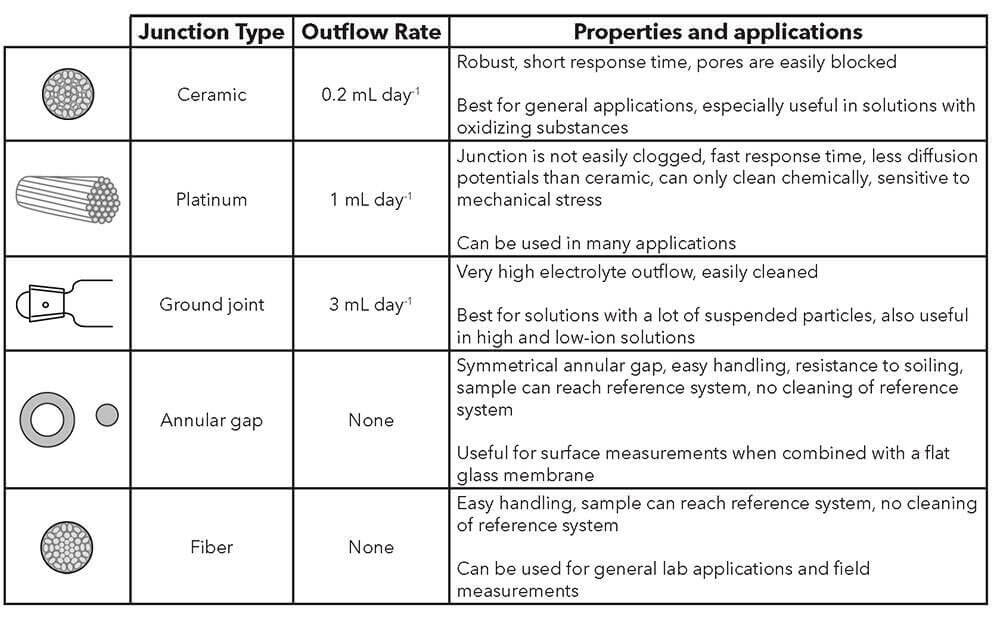
Table 2: Types of reference junctions
Ceramic Junction
A ceramic junction uses the porosity of unglazed ceramic. Ceramic junctions have a KCl outflow rate of ~0.2 mL/day and a relatively high electrical resistance (1 kΩ).
Because the concentration gradient at the junction is so wide, diffusion potentials are easily generated in measurement fluids with higher ionic strength. The resistance of the test material in lower ionic strength solutions may be too great for precise readings. Because the low outflow rate amplifies both effects, ceramic joints are less appropriate in such situations. It is also unsuitable for solutions containing suspended particles due to the increased likelihood of pore obstruction. The ceramic junction is preferable to the platinum junction only in measurement solutions that contain oxidizing chemicals.
Platinum Junction
The platinum junction consists of fine, twisted platinum filaments between which the electrolyte flows out along precisely defined channels. The platinum junction features a very constant outflow and does not easily become blocked. With an outflow rate of ~ 1 mL / day and electrical resistance of ~ 0.5 k , it has advantages over ceramic junctions. Because of the presence of disruptive potentials, the platinum connection is more susceptible to mechanical stress and is less than ideal for highly oxidizing or reducing solutions. The platinum connection, on the other hand, may be utilized nearly everywhere.

Image: TruLine pH 17 electrode with platinum junction
Ground-joint Junction
The ground-joint junction works with the thin gap of the unlubricated ground glass as an outflow opening for the electrolyte. The outflow rate is ~ 3 mL / day and greater. It features a very low electrical resistance (0.1 kΩ). Because it is easy to clean, the ground-joint connection is ideal for measurements in polluted solutions. It is appropriate for both high and low-ion solutions due to the high outflow rate.

Image: TruLine pH 25 electrode with plastic fibre junction
Additional Reference Junctions
Additional junctions can be added to protect the reference system from contamination. The reference electrode is submerged in electrolyte solution within an extra chamber in this arrangement. This extra chamber serves as a secondary barrier against contamination, while additional connections ensure that the reference system remains in touch with the measuring fluid.
The measuring solution can still contaminate the reference system, but it must first diffuse through the extra connection (s).
The Silamid reference system by YSI is a special type of double junction electrode that utilizes a unique construction of the silver/silver chloride reference system. Most electrodes featuring a Ag/AgCl system are built with an Ag wire coated with AgCl. Silamid reference systems have a glass tube with the inner part coated with Ag, then filled with AgCl, and plugged with a polyester fibre. This reference system creates greater contact surface area between Ag and AgCl compared to the standard Ag/AgCl wire system, resulting in a reference system that is long lasting and very stable. The Science series of electrodes from YSI feature the Silamid reference system.
Want to Know More?
Lab Unlimited has a variety of YSI platforms for the measurement of pH. Whether for the lab (MultiLab, TruLab), environmental sampling (Pro Plus, ProDSS, Pro10), or for long-term monitoring (EXO1, EXO2).
Contact our Sales Team today and find perfect solution for your needs!
Contact us Today! |
